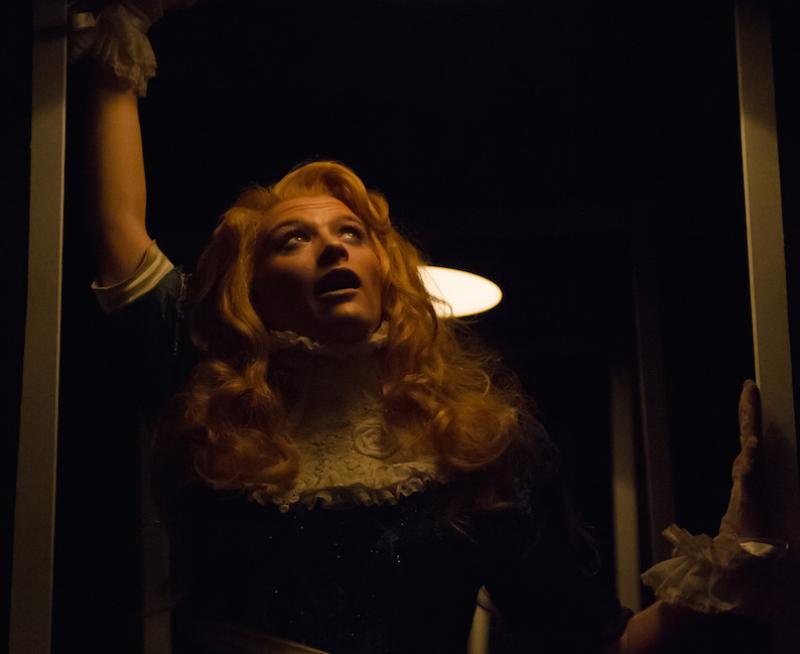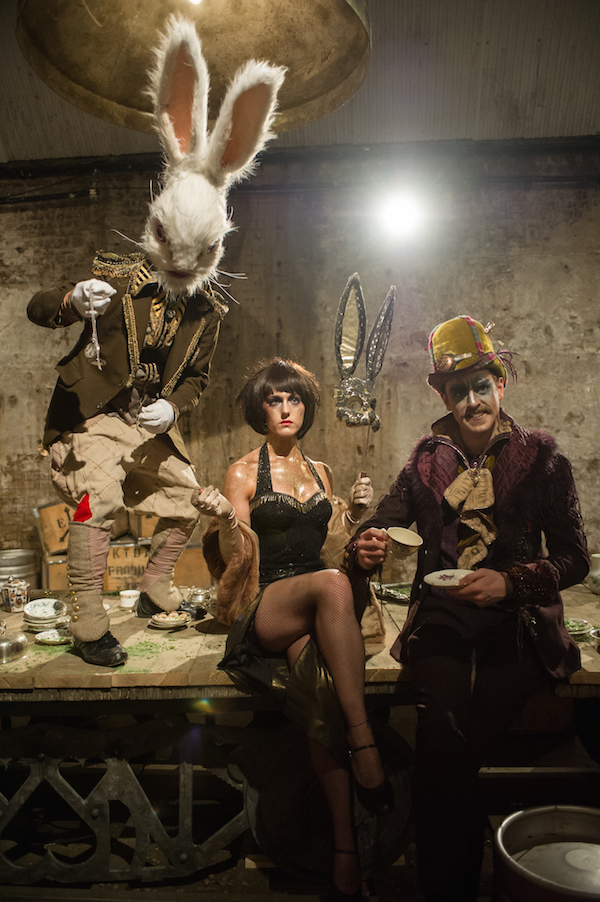Alice's Adventures Underground, The Vaults | reviews, news & interviews
Alice's Adventures Underground, The Vaults
Alice's Adventures Underground, The Vaults
New subterranean Alice offers an engaging alternative journey

The 150th anniversary of Lewis Carroll’s seminal novel has inspired a raft of commemorative works, from Damon Albarn and Moira Buffini’s musical Wonder.land to Holland Park opera and Glastonbury’s surrealist haven; Disney’s film sequel arrives next year. Les Enfants Terribles’ contribution takes a literal trip down the rabbit hole, guiding audiences into the depths of Waterloo Vaults.
“Begin at the beginning, and go on till you come to the end,” counselled the King of Hearts, so Anthony Spargo’s adaptation commences with Carroll’s dusty treasure trove of a study. From there, our paths diverge: viewers are divided by the choice of “Eat Me” or “Drink Me”, then further split into groups based on playing card suits. You might visit the caterpillar’s hookah lounge, make jam tarts in the kitchen, or, if enlisted in the guard unit, join the Cheshire Cat in spying on rebels. In this dystopian universe, Alice is trapped behind the looking glass and nonsense is outlawed under the Queen’s reign of terror.
While the division ensures a variety of experiences – and makes for lively post-show discussion – it seems a shame to entirely exclude some areas. Unlike other more freeform immersive productions, there is no individual wandering, with each group closely monitored on their journey through Samuel Wyer’s book-filled corridors. The competing team element does contribute to the courtroom climax, though it’s a payoff in need of further elucidation.
The more prosaic reason for co-directors Oliver Lansley and James Seager’s insistence on military precision is the mind-boggling logistics of a show that plays on a loop multiple times a night, with overlapping casts. This ambition makes production deficiencies forgivable, although Alice’s anarchic spirit is subdued when queuing dominates so heavily. Sound balance also needs addressing – either too quiet or bleeding between rooms. Tireless guides cover lapses with good-natured vamping.
 If not a shining example of dramatic momentum, there are plenty of gems: the evocative zoetrope whirling us into Wonderland; a vast, Steampunk tea party (pictured left), where Richard Holt’s Hatter, Caitlin Thorburn’s March Hare and John Leader’s Dormouse torment the beleaguered White Rabbit (Mark Stevenson); Matt Crouziers and John Cockerill’s Tweedledum and Tweedledee bickering while tumbling on wires; Lucy Farrett’s ghostly Alice darting between mirrors, desperately seeking her identity; and Abby Wain’s corporeal version, challenging Alison Fitszjohn’s scarlet despot. Tom Sutcliffe’s Mock Turtle provides the standout segment with his haunting lament (composed by Tomas Gisby), crooned while floating on an ever-filling sea of tears. It’s a beautiful distillation of the melancholy at the root of Carroll’s sublime silliness.
If not a shining example of dramatic momentum, there are plenty of gems: the evocative zoetrope whirling us into Wonderland; a vast, Steampunk tea party (pictured left), where Richard Holt’s Hatter, Caitlin Thorburn’s March Hare and John Leader’s Dormouse torment the beleaguered White Rabbit (Mark Stevenson); Matt Crouziers and John Cockerill’s Tweedledum and Tweedledee bickering while tumbling on wires; Lucy Farrett’s ghostly Alice darting between mirrors, desperately seeking her identity; and Abby Wain’s corporeal version, challenging Alison Fitszjohn’s scarlet despot. Tom Sutcliffe’s Mock Turtle provides the standout segment with his haunting lament (composed by Tomas Gisby), crooned while floating on an ever-filling sea of tears. It’s a beautiful distillation of the melancholy at the root of Carroll’s sublime silliness.
A more consistent tone would lift the production – is this primarily haunted house, museum, revue or theme park? – as would further stimulation and interaction; companies like Punchdrunk have raised the immersive theatre bar. The mode of delivery is a little too conservative to epitomise Carroll’s kaleidoscopic dreamscape, but, if lacking in the requisite six impossible things before breakfast, there’s still plenty here for both children and children at heart.
rating
Explore topics
Share this article
The future of Arts Journalism
You can stop theartsdesk.com closing!
We urgently need financing to survive. Our fundraising drive has thus far raised £49,000 but we need to reach £100,000 or we will be forced to close. Please contribute here: https://gofund.me/c3f6033d
And if you can forward this information to anyone who might assist, we’d be grateful.

Subscribe to theartsdesk.com
Thank you for continuing to read our work on theartsdesk.com. For unlimited access to every article in its entirety, including our archive of more than 15,000 pieces, we're asking for £5 per month or £40 per year. We feel it's a very good deal, and hope you do too.
To take a subscription now simply click here.
And if you're looking for that extra gift for a friend or family member, why not treat them to a theartsdesk.com gift subscription?
more Theatre
 The Line of Beauty, Almeida Theatre review - the 80s revisited in theatrically ravishing form
Alan Hollinghurst novel is cunningly filleted, very finely acted
The Line of Beauty, Almeida Theatre review - the 80s revisited in theatrically ravishing form
Alan Hollinghurst novel is cunningly filleted, very finely acted
 Wendy & Peter Pan, Barbican Theatre review - mixed bag of panto and comic play, turned up to 11
The RSC adaptation is aimed at children, though all will thrill to its spectacle
Wendy & Peter Pan, Barbican Theatre review - mixed bag of panto and comic play, turned up to 11
The RSC adaptation is aimed at children, though all will thrill to its spectacle
 Hedda, Orange Tree Theatre review - a monument reimagined, perhaps even improved
Scandinavian masterpiece transplanted into a London reeling from the ravages of war
Hedda, Orange Tree Theatre review - a monument reimagined, perhaps even improved
Scandinavian masterpiece transplanted into a London reeling from the ravages of war
 The Assembled Parties, Hampstead review - a rarity, a well-made play delivered straight
Witty but poignant tribute to the strength of family ties as all around disintegrates
The Assembled Parties, Hampstead review - a rarity, a well-made play delivered straight
Witty but poignant tribute to the strength of family ties as all around disintegrates
 Mary Page Marlowe, Old Vic review - a starry portrait of a splintered life
Tracy Letts's Off Broadway play makes a shimmeringly powerful London debut
Mary Page Marlowe, Old Vic review - a starry portrait of a splintered life
Tracy Letts's Off Broadway play makes a shimmeringly powerful London debut
 Little Brother, Soho Theatre review - light, bright but emotionally true
This Verity Bargate Award-winning dramedy is entertaining as well as thought provoking
Little Brother, Soho Theatre review - light, bright but emotionally true
This Verity Bargate Award-winning dramedy is entertaining as well as thought provoking
 The Unbelievers, Royal Court Theatre - grimly compelling, powerfully performed
Nick Payne's new play is amongst his best
The Unbelievers, Royal Court Theatre - grimly compelling, powerfully performed
Nick Payne's new play is amongst his best
 The Maids, Donmar Warehouse review - vibrant cast lost in a spectacular-looking fever dream
Kip Williams revises Genet, with little gained in the update except eye-popping visuals
The Maids, Donmar Warehouse review - vibrant cast lost in a spectacular-looking fever dream
Kip Williams revises Genet, with little gained in the update except eye-popping visuals
 Ragdoll, Jermyn Street Theatre review - compelling and emotionally truthful
Katherine Moar returns with a Patty Hearst-inspired follow up to her debut hit 'Farm Hall'
Ragdoll, Jermyn Street Theatre review - compelling and emotionally truthful
Katherine Moar returns with a Patty Hearst-inspired follow up to her debut hit 'Farm Hall'
 Troilus and Cressida, Globe Theatre review - a 'problem play' with added problems
Raucous and carnivalesque, but also ugly and incomprehensible
Troilus and Cressida, Globe Theatre review - a 'problem play' with added problems
Raucous and carnivalesque, but also ugly and incomprehensible
 Clarkston, Trafalgar Theatre review - two lads on a road to nowhere
Netflix star, Joe Locke, is the selling point of a production that needs one
Clarkston, Trafalgar Theatre review - two lads on a road to nowhere
Netflix star, Joe Locke, is the selling point of a production that needs one
 Ghost Stories, Peacock Theatre review - spirited staging but short on scares
Impressive spectacle saves an ageing show in an unsuitable venue
Ghost Stories, Peacock Theatre review - spirited staging but short on scares
Impressive spectacle saves an ageing show in an unsuitable venue

Add comment